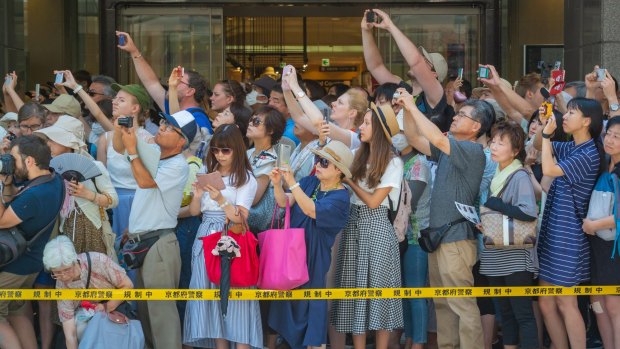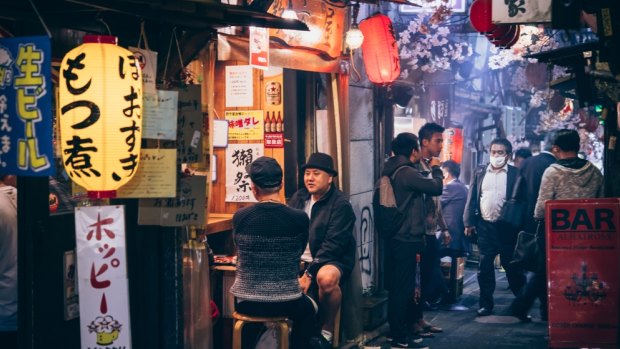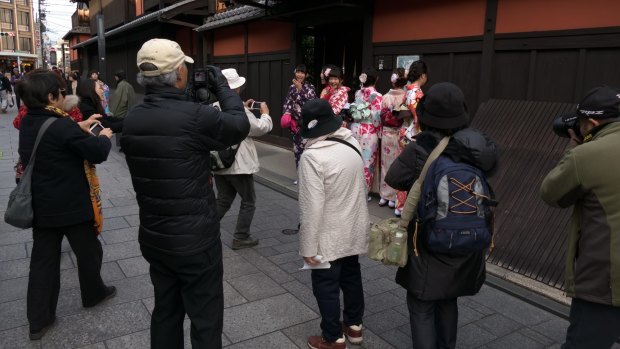This was published 5 years ago
Overtourism Japan: Tourist sites turn away tour groups due to bad behaviour
By Lorna Thornber

Tourists in Kyoto.Credit: Alamy
An increasing number of tourist sites in Japan are turning away foreign groups of tourists due to their bad behaviour.
Japan's Asahi Shimbun reported that despite their best efforts to prevent the offensive behaviour, that did not stop the "abhorrent actions" and bad manners of some visitors, encroaching upon their business and reputation.
Nanzoin, a well-known temple in Sasaguri in the Fukuoka Prefecture, has put up signs in 12 languages telling groups of visitors from overseas that they are not welcome there.
The temple's chief priest Kakujo Hayashi told the publication that overseas visitors have been causing problems for about 10 years.
Many are cruise passengers, who arrive in buses and disrespect the sacred site, he said. Unacceptable behaviour has included playing loud music, splashing in sacred waterfalls and climbing on buildings.
Efforts to stop such behaviour have failed, effectively driving away local worshippers.
"We have no choice but to take measures to protect the place of prayer on our own," Hayashi said.
Foreign visitors to Japan reached a record high of 30 million in 2018, and that number is set to rise this year.
While the Japanese government hopes the number of overseas visitors will hit 40 million in 2020, when Tokyo hosts the Olympic Games, some local businesspeople feel foreign tourists are more trouble than they're worth.
The owner of an izakaya (pub) in Kyoto said he had started to tell groups of overseas visitors that his venue was full, even if it wasn't. He has become fed up, he said, with foreign visitors bringing in food from convenience stores, using plates as ashtrays and flicking ash onto the floor.
"I want Kyoto to stop staging promotional campaigns targeting foreign sightseers," he said.

Credit: Shutterstock
The Yatsushiro shrine in Yatsushiro in the Kumamoto Prefecture temporarily banned overseas visitors in 2017 after the number of cruise ships calling at a nearby port had increased by six times.
"We did not want to cause problems for other worshippers," Masataka Takehara, a senior priest at the shrine, said.
The shrine reopened in January 2018 after the city council intervened, but Takehara said the priests "would like visitors to understand the minimum required manners".
Noriko Matsunaga, a multicultural society professor at Kyushu University, said banning groups of overseas visitors does not amount to discrimination if individuals are still allowed in.
However, Matsunaga said he believes cultural differences are the root of the problem and that refusing foreign visitors may make things worse.
"If people lose their desire to welcome those from abroad, the trend could gain momentum throughout Japan.
"What is important is enhancing mutual cultural understanding in line with the central government's policy to welcome foreign tourists."
Takako Ikado, an associate professor of tourism management at Takasaki City University of Economics, said central and local governments should educate overseas visitors on social protocols such as keeping quiet in certain situations and "paying attention to cleanliness".
For visitors though, there is certainly no harm in brushing up on Japanese etiquette ahead of a trip. It might just help you access areas others can't.
Japanese etiquette 101

Credit: Alamy
Bow
A bow means hello in Japanese body language, but a quick lean forward will not suffice in some situations. Long, deep bows are a sign of respect but a short nod of the head should do in casual situations such as when entering a shop. There's no need to place your palms together. Bowing is also used to thank, apologise and make a request.
Take off your shoes
Remove your shoes whenever you enter someone's home and at any restaurant or temple where you see shoes lined up. It's polite to leave them pointing towards the door. And make sure your socks are presentable. If you're not wearing socks, bring a pair with you to put on indoors.
Remember to take off the toilet slippers
If you use the loo in a private home, minshuku or ryokan, you may find a pair of slippers has been provided for you to wear while you do your business. By all means make use of them, but don't forget to change back into your own slippers afterwards. Wearing the toilet slippers in other parts of the building is a big no no.
Don't lather up in the bath
Don't just run the water and jump in. As at an onsen (hot pool) or sento (public bath), you should rinse your body before getting into the tub, either in the shower or using the washbowl. Tubs are for soaking only - no soaping. Don't break out that bar of soap until you're back in the shower or by the washbowl. Once you've washed it all off, get back into the bath for a final soak. Typically, all members of a household use the same bathwater, hence the need to keep it as clean as possible.
Don't stick your chopsticks in your food
Using chopsticks correctly in Japan isn't just a matter of getting a good enough grip on your food to ensure you don't get half of it down your front en route to your mouth. There are many rules but you should be fine if you refrain from sticking your chopsticks into your food and passing food from your own set of chopsticks to another's as both of these are funeral rites. Don't spear food with your chopsticks, point with them or use them to move bowls or plates around. Oh, and when you're finished eating, lay them down in front of you with the tips pointing to the left.
Visiting a temple
Keep quiet and show your respect by contributing a coin to the offering box beside the sacred object and saying a short prayer or just gazing at it contemplatively. If you decide to burn incense, light it and let it burn for just a few seconds before extinguishing the flame with your hand. Put it into the burner and fan some of the smoke towards yourself as inhaling it is believed to be healing. If you have an injury, direct the smoke towards that.
Visiting a shrine
Traditionally, you shouldn't visit if you are sick, in mourning or have an open wound as these are considered impurities. At the purification fountain near the entrance, fill one of the provided ladles with water and wash both hands. Next, transfer some water from your cupped hand to your mouth, rinse your mouth and and spit the water out beside the fountain. In the offering hall, put a coin in the box, bow twice, clap your hands twice, bow once more and pray - or stand in quiet contemplation - for a few seconds.
Take business cards
Even if your trip is for pleasure, you should have a stash handy. The exchange of business cards is an important transaction in Japan; a way of demonstrating your interest in another person and respecting their position and career.
Don't eat on the run
Eating on the street is not the done thing in Japan, even with takeaways. Eat your food and drink your coffee in the place you bought it to avoid stares and silent judgement.
Make sure you have somewhere to stow rubbish
Rubbish bins are a rare beast in public places in Japan. It's expected that you will do as you would in the New Zealand bush and take it home with you.
Don't try to grab a selfie with a geisha
The geishas in Kyoto, who are actually called geikos or maikos, have been mobbed by tourists trying to get a photo as they make their way to work. This is considered very bad form and adds to the already substantial risk to the long-term viability of this ancient tradition.
See also: No tattoos, no alcohol: The rules of getting naked in Japan
See also: Overtourism is about to ruin our favourite place to travel
Sign up for the Traveller Deals newsletter
Get exclusive travel deals delivered straight to your inbox. Sign up now.